Early Ordovician Age of Fluorite-Rare-Metal Deposits at the Voznesensky Ore District (Far East, Russia): Evidence from Zircon and Cassiterite U–Pb and Fluorite Sm–Nd Dating Results
Abstract
:1. Introduction
2. Characteristics of the Voznesensky Complex
3. Sample Descriptions
4. Analytical Methods
4.1. Zircon U–Pb SHRIMP and Trace Element Microanalysis
4.2. Fluorite Sm–Nd Geochronology
4.3. Cassiterite U–Pb TIMS Geochronology
5. Results
5.1. Zircon U–Pb SIMS Geochronology
5.2. Zircon Trace Element Composition
5.3. Fluorite Sm–Nd Geochronology
5.4. Cassiterite ID-TIMS U–Pb Geochronology
6. Discussion
7. Conclusions
- Overlapping within their errors, concordant U–Pb ages of two zircon samples were established at 478 ± 4 Ma and 481 ± 7 Ma of biotite leucogranites, which should be considered as the age of the magmatic crystallization of granites of the Voznesensky complex.
- The composition of the studied zircon, on the one hand, demonstrated the typical features of magmatic zircon in granitoids; on the other hand, it had the characteristic features of zircon that interacted with fluids at the late/postmagmatic stage.
- According to the results of the Sm–Nd isochron analysis of fluorites, the age of the rare-metal–fluorite mineralization of the Voznesenskoe deposit was established as 477 ± 9 Ma. Based on the results of the U–Pb ID-TIMS isotope dating of cassiterites, the age of the tin mineralization of the Yaroslavskoe and Chapaevskoe deposits was equal to 480 ± 4 Ma. These results supported the direct genetic and age relationship of ore formation within the Voznesensky ore district with early Ordovician granite magmatism.
Author Contributions
Funding
Data Availability Statement
Acknowledgments
Conflicts of Interest
References
- Khanchuk, A.I.; Ratkin, V.V.; Ryazantseva, M.D.; Golozubov, V.V.; Gonokhova, N.G. Geology and Mineral Deposits of Primorsky Krai (Territory); Dalnauka: Vladivostok, Russia, 1996; p. 61. (In Russian) [Google Scholar]
- Nedra. Genetic Types of Hydrothermal Deposits of Beryllium; Ginzburg, A.I., Ed.; Nedra: Moscow, Russia, 1975; p. 247. (In Russian) [Google Scholar]
- Govorov, I.N. Geokhimiya Rudnykh Raionov Primor’ya (Geochemistry of ore Districts in Primorye); Nauka: Moscow, Russia, 1977; p. 250. (In Russian) [Google Scholar]
- Govorov, I.N.; Blagodareva, N.S.; Zhuravlev, D.Z. Petrogenesis of fluorite deposits of the Voznesenovsky ore region (Primorye) according to the Rb-Sr isotopic data of igneous and metasomatic rocks. Pac. Geol. 1997, 16, 60–69. [Google Scholar]
- Rub, A.K.; Rub, M.G. Rare earth elements of igneous rocks in some regions of the Far East. Acad. Sci. USSR Ser. Geol. 1989, 2, 62–72. [Google Scholar]
- Rub, M.G.; Rub, A.K. Petrology of rare-metal granites from the Voznesenk ore-bearing area, Primor’e, Russia. Petrology 1994, 2, 43–67. [Google Scholar]
- Rub, A.K.; Rub, M.G. Rare-Metal Granites of Primorye; VIMS: Miscow, Russia, 2006; p. 86. (In Russian) [Google Scholar]
- Ryazantseva, M.D.; Gerasimov, N.S.; Govorov, I.N. Rb-Sr isochrons and petrogenesis of igneous rocks of the Voznesenka ore district. Pac. Geol. 1994, 13, 60–73. [Google Scholar]
- Ryazantseva, M.D.; Kupriyanova, I.I.; Belyatskiy, B.V.; Krymskiy, R.S.; Shpanov, E.P. Age genetic relationships of igneous rocks rare-metal-fluorite mineralization of the Voznesensky Ore District, (Primorye). Pac. Geol. 2003, 22, 87–102. [Google Scholar]
- Kupriyanova, I.I.; Shpanov, E.P. Beryllium-fluorite ores at the Voznesensk ore district (Primorskii Krai, Russia). Geol. Ore Depos. 1997, 39, 442–455. [Google Scholar]
- Kupriyanova, I.I.; Belyatsky, B.V.; Shpanov, E.P.; Kukushkina, O.I.; Kuvshinova, K.A.; Rassulov, V.A. The role of mineral typomorphism in the interpretation of isotope data (on the example of fluorite in the Voznesensky ore district). Petrology 2004, 12, 530–546. [Google Scholar]
- Kupriyanova, I.I.; Ryazantseva, M.D.; Belyatsky, B.V.; Shpanov, E.P. Geological and structural conditions for the manifestation of magmatic processes and the formation of large complex deposits of the Voznesensky ore district (Primorye, Russia). Geol. Ore Depos. 2005, 47, 127–147. [Google Scholar]
- Kupriyanova, I.I.; Shpanov, E.P. Beryllium Deposits of Russia; VIMS: Moscow, Russia, 2011; p. 353. [Google Scholar]
- Khanchuk, A.I.; Sakhno, V.G.; Alenicheva, A.A. First SHRIMP U-Pb zircon dating of magmatic complexes in the Southwestern Primor’e Region. Dokl. Earth Sci. 2010, 431, 424–428. [Google Scholar] [CrossRef]
- Belyatsky, B.V.; Krymsky, R.S.; Rub, M.G.; Pavlov, V.A.; Rub, A.K. Age and genetic relationships or rare-metal ore-bearing granites of Voznesenka ore fild, Primorye: Rb-Sr and Sm-Nd isotopic date. In Mineral Deposits: Processes to Processing; Stanley, C.J., Ed.; Balkema: Rotterdam, The Netherlands, 1999; pp. 313–316. [Google Scholar]
- Sato, K.; Suzuki, K.; Nedachi, M.; Terashima, S.; Pyazantseva, M.; Vrublevsky, A.; Khanchuk, A. Fluorite deposits at Voznesenka in the Khanka massif, Russia: Geology and age of mineralization. Resour. Geol. 2003, 53, 193–211. [Google Scholar] [CrossRef]
- Nokleberg, W.J. (Ed.) Metallogenesis and Tectonics of Northeast Asia; USGS: Reston, VA, USA, 2010; pp. 542–549.
- Khetchikov, L.N.; Govorov, I.N.; Pakhomova, V.A.; Androsov, D.V. New data on genesis of lithium-fluorite granite of the Khanka medium massif: U.S.S.R. Acad. Sci. Trans. 1992, 322, 1121–1127. (In Russian) [Google Scholar]
- Rizvanova, N.G.; Kuznetsov, A.B. A new approach to ID-TIMS U–Pb dating of cassiteriteby the example of the Pitkaranta Tin deposit. Dokl. Earth Sci. 2020, 491, 146–149. [Google Scholar] [CrossRef]
- Petrishchevsky, A.M. Deep Structures of the Voznesensky Fluorite Region; Dalnauka: Vladivostok, Russia, 2002; p. 106. [Google Scholar]
- Pearce, Y.A.; Harris, N.B.V.; Tindle, A.G. Trace element discrimination diagram for the tectonic interpretation of granitic rocks. Petroleum 1984, 70, 956–983. [Google Scholar] [CrossRef] [Green Version]
- Black, L.P.; Kamo, S.L.; Allen, C.M.; Aleinikoff, J.N.; Davis, D.W.; Korsch, R.J.; Foudoulis, C. TEMORA 1: A new zircon standard for phanerozoic U-Pb geochronology. Chem. Geol. 2003, 200, 155–170. [Google Scholar] [CrossRef]
- Wiedenbeck, M.; Allé, P.; Corfu, F.; Griffin, W.L.; Meier, M.; Oberli, F.; Von QuADT, A.; Roddick, J.C.; Spiegel, W. Three natural zircon standards for U-Th-Pb, Lu-Hf, trace element and ree analyses. Geostand. Newsl. 1995, 19, 1–23. [Google Scholar] [CrossRef]
- Williams, I.S. U-Th-Pb Geochronology by ion microprobe. In Applications of Microanalytical Techniques to Understanding Mineralizing Processes; McKibben, M., Shanks, W., Ridley, W., Eds.; Society of Economic Geologists: Littleton, CO, USA, 1998; Volume 7, pp. 1–35. [Google Scholar]
- Schuth, S.; Gornyy, V.I.; Berndt, J.; Shevchenko, S.S.; Sergeev, S.A.; Karpuzov, A.F.; Mansfeldt, T. Early proterozoic u-pb zircon ages from basement gneiss at the Solovetsky Archipelago, White Sea, Russia. Int. J. Geosci. 2012, 3, 289–296. [Google Scholar] [CrossRef] [Green Version]
- Stacey, J.S.; Kramers, J.D. Approximation of terrestrial lead isotope evolution by a two-stage model. Earth Planet Sci. Lett. 1975, 26, 207–221. [Google Scholar] [CrossRef]
- Ludwig, K.R. SQUID 1.02, A User Manual, A Geochronological Toolkit for Microsoft Excel; Berkeley Geochronology Center Spec. Publ.: Berkeley, CA, USA, 2001. [Google Scholar]
- Ludwig, K.R. User’s Manual for Isoplot/Ex, Version 3.00, A Geochronological Toolkit for Microsoft Excel; Berkeley Geochronology Center Spec. Publ.: Berkeley, CA, USA, 2003. [Google Scholar]
- Dokukina, K.A.; Kaulina, T.V.; Konilov, A.N.; Mints, M.V.; Van, K.V.; Natapov, L.; Belousova, E.; Simakin, S.G.; Lepekhina, E.N. Archaean to Palaeoproterozoic high-grade evolution of the Belomorian eclogite province in the Gridino area, Fennoscandian Shield: Geochronological evidence. Gondwana Res. 2014, 25, 585–613. [Google Scholar] [CrossRef]
- Fedotova, A.A.; Bibikova, E.V.; Simakin, S.G. Ion-microprobe zircon geochemistry as an indicator of mineral genesis during geochronological studies. Geochem. Int. 2008, 46, 912–927. [Google Scholar] [CrossRef]
- McDonough, W.F.; Sun, S.S. The composition of the Earth. Chem. Geol. 1995, 120, 223–253. [Google Scholar] [CrossRef]
- Watson, E.B.; Wark, D.A.; Thomas, J.B. Crystallization thermometers for zircon and rutile. Contrib. Miner. Petrol. 2006, 151, 413–433. [Google Scholar] [CrossRef]
- Gulson, B.L.; Jones, M.T. Cassiterite: Potential for direct dating of mineral deposits and a precise age for the bushveld complex granites. Geology 1992, 20, 355–358. [Google Scholar] [CrossRef]
- Tapster, S.; Bright, J. High-precision ID-TIMS Cassiterite U-Pb systematics using a low-contamination hydrothermal decomposition: Implications for LA-ICP-MS and ore deposit geochronology. EGU Geochronol. 2020, 2, 425–441. [Google Scholar] [CrossRef]
- Carr, P.; Zink, S.; Bennett, V.; Norman, M.; Amelin, Y.; Blevin, P.L. A new method for U-Pb geochronology of cassiterite by ID-TIMS applied to the Mole Granite polymetallic system, eastern Australia. Chem. Geol. 2020, 539, 1–10. [Google Scholar] [CrossRef]
- Manhes, G.; Minster, J.E.; Allegre, C.J. Comparative uranium-thorium-lead and rubidium-strontium study of the Severin Amphoterite: Consequences for early Solar System chronology. Earth Planet Sci. Lett. 1978, 39, 14–24. [Google Scholar] [CrossRef]
- Kirkland, C.L.; Smithies, R.H.; Taylor, R.J.M.; Evans, N.; McDonald, B. Zircon Th/U ratios in magmatic environs. Lithos 2015, 212, 397–414. [Google Scholar] [CrossRef]
- Geisler, T.; Scheicher, H. Improved U-Th-total Pb-dating of zircons by electron microprobe using a simple new background modeling procedure and Ca as a chemical criterion of fluid-induced U-Th-Pb discordance in zircon. Chem. Geol. 2000, 163, 269–285. [Google Scholar] [CrossRef]
- Finch, R.J.; Hanchar, J.M. Structure and chemistry of zircon and zircon-group minerals. Rev. Miner. Geochem. 2003, 53, 1–25. [Google Scholar] [CrossRef]
- Belousova, E.; Griffin, W.; O’Reilly, S.Y.; Fisher, N. Igneous zircon; Trace element composition as an indicator of source rock type. Contrib. Miner. Petrol. 2002, 143, 602–622. [Google Scholar] [CrossRef]
- Fu, B.; Page, F.Z.; Cavoise, A.J.; Fournelle, J.; Kita, N.T.; Lackey, J.S.; Wilde, S.A.; Valley, J.W. Ti-in-zircon thermometry: Applications and limitations. Contrib. Miner. Petrol. 2008, 156, 197–215. [Google Scholar] [CrossRef]
- Barth, A.P.; Wooden, J.L. Coupled elemental and isotopic analyses of polygenetic zircons from granitic rocks by ion microprobe, with implications for melt evolution and the sources of granitic magmas. Chem. Geol. 2010, 277, 149–159. [Google Scholar] [CrossRef]
- Ushikubo, T.; Kita, N.T.; Cavoise, A.J.; Wilde, S.A.; Rudnick, R.L.; Valley, J.W. Lithium in jack hills zircons: Evidence for extensive weathering of Earth’s earliest crust. Earth Planet. Sci. Lett. 2008, 272, 666–676. [Google Scholar] [CrossRef]
- Hoskin, P.W.O. Trace-element composition of hydrothermal zircon and the alteration of Hadean zircon from the Jack Hills, Australia. Geochim. Cosmochim. Acta 2005, 69, 637–648. [Google Scholar] [CrossRef]
- Grimes, C.B.; Ushikubo, T.; John, B.E.; Valley, J.W. Uniformly mantle-like δ18O in zircons from oceanic plagiogranites and gabbros. Contrib. Miner. Petrol. 2011, 161, 13–33. [Google Scholar] [CrossRef]
- Bouvier, A.-S.; Ushikubo, T.; Kita, N.T.; Cavoise, A.J.; Kozdon, R.; Valley, J.W. Li isotopes and trace elements as a petrogenetic tracer in zircon: Insights from Archean TTGs and sanukitoids. Contrib. Miner. Petrol. 2012, 163, 745–768. [Google Scholar] [CrossRef]
- Deng, X.H.; Chen, Y.J.; Yao, J.M.; Bagas, L.; Tang, H.S. Fluorite REE-Y (REY) geochemistry of the ca. 850 Ma Tumen molybdenite-fluorite deposit, eastern Qinling, China: Constraints on ore genesis. Ore Geol. Rev. 2014, 63, 532–543. [Google Scholar] [CrossRef]
- Li, C.; Zhang, R.; Ding, X.; Ling, M.; Fan, W.; Sun, W. Dating cassiterite using laser ablation ICP-MS. Ore Geol. Rev. 2016, 72, 313–322. [Google Scholar] [CrossRef]
- Ludwig, K.R. On the treatment of concordant uranium-lead ages. Geochim. Cosmochim. Acta 1998, 62, 665–676. [Google Scholar] [CrossRef]
- Xu, T.; Xu, W.L.; Wang, F.; Ge, W.C.; Sorokin, A.A. Geochronology and geochemistry of early Paleozoic intrusive rocks from the Khanka Massif in the Russian Far East: Petrogenesis andtectonic implications. Lithos 2018, 300–301, 105–120. [Google Scholar] [CrossRef]
- Mishkin, M.A.; Khanchuk, A.I.; Zhuravlev, D.P.; Lavrik, S.N. First data on the Sm–Nd systematics of metamorphic rocks in the Khankai Massif, Primor’e region. Dokl. Earth Sci. 2000, 374, 1283–1285. [Google Scholar]
- Kruk, N.N.; Golozubov, V.V.; Kiselev, V.I.; Kruk, E.A.; Rudnev, S.N.; Serov, P.A.; Kasatkin, S.A.; Moskalenko, E.Y. Paleozoic granitoids of the southern part of the Voznesenka Terrane (South Primorye): Age, composition, melt sources and Tectonic setting. Pac. Geol. 2018, 12, 190–209. [Google Scholar] [CrossRef]

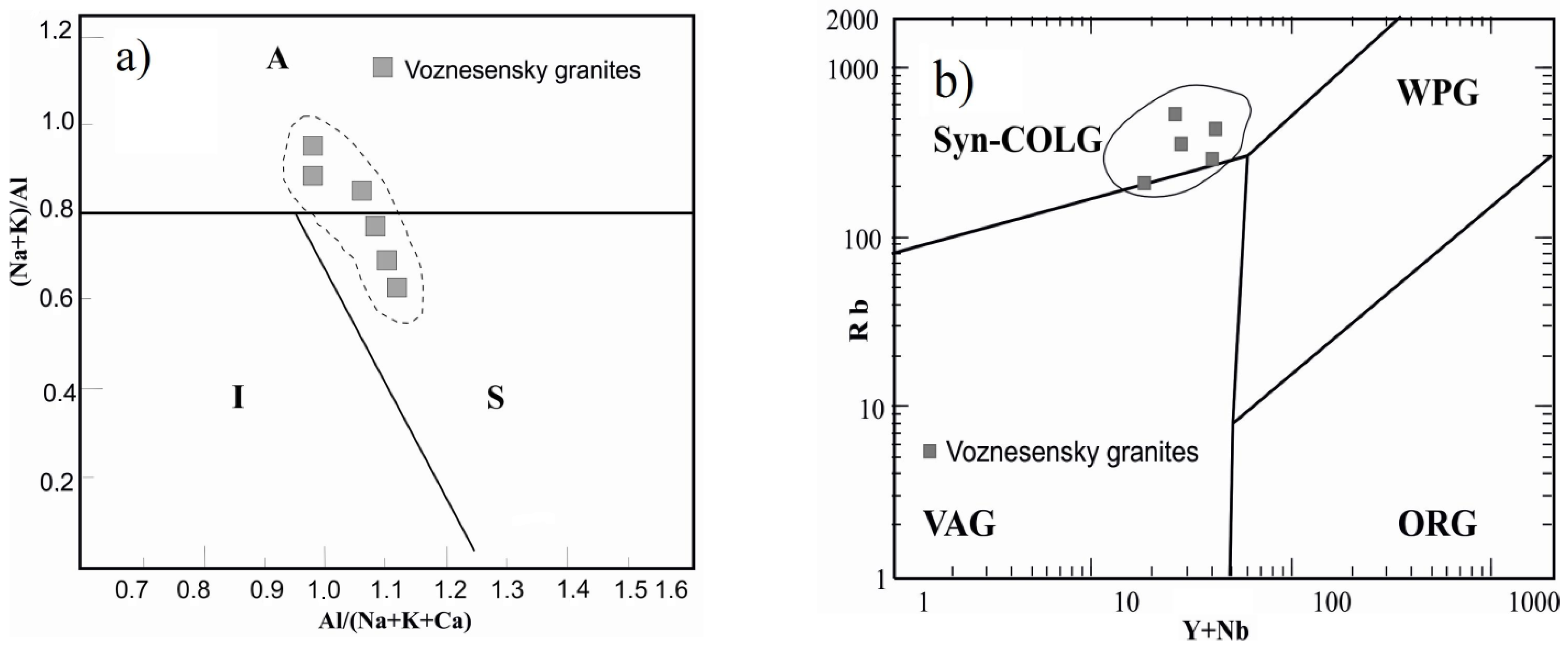
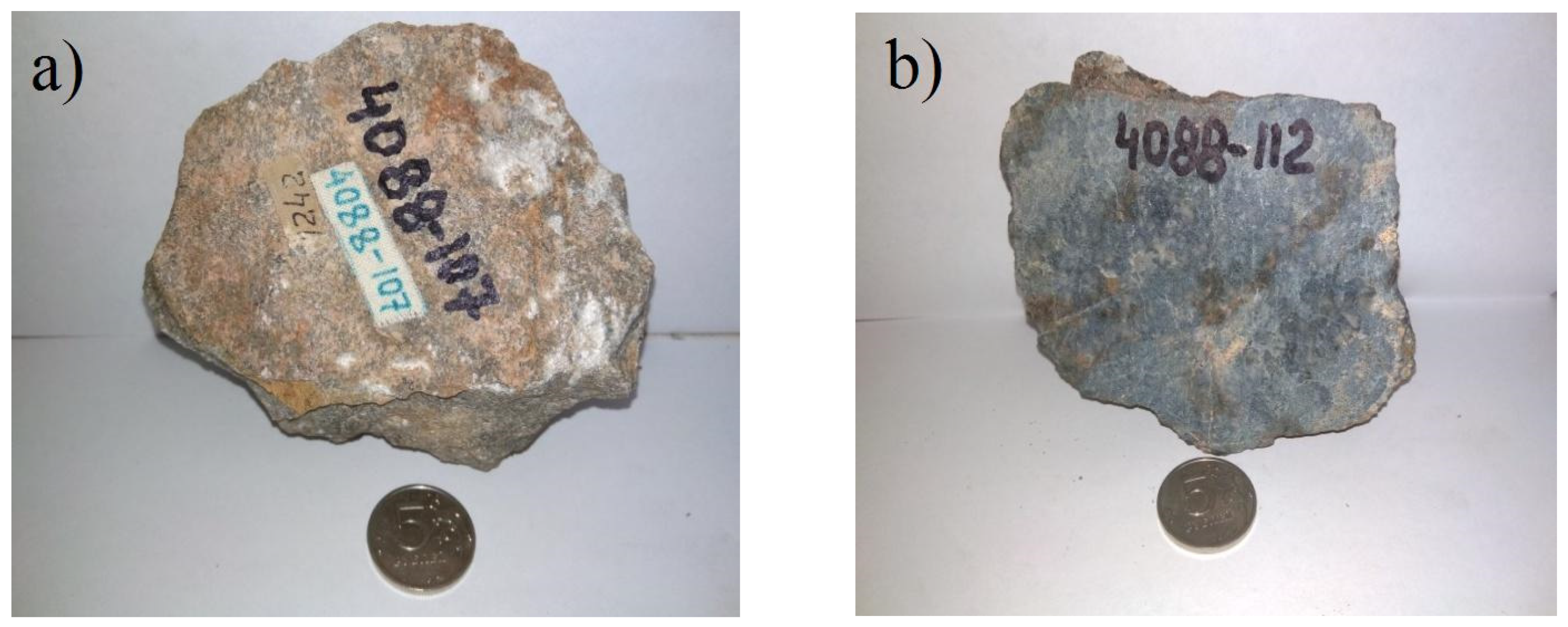



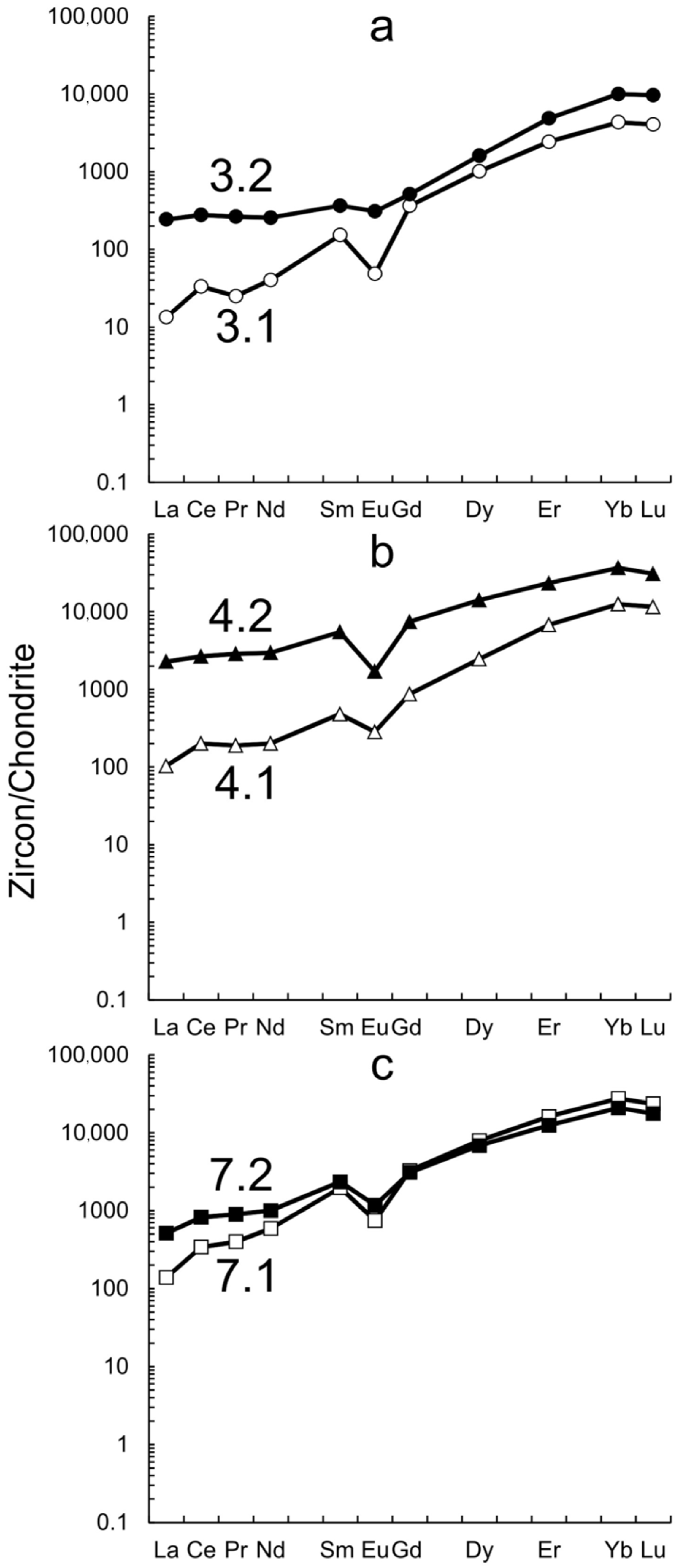
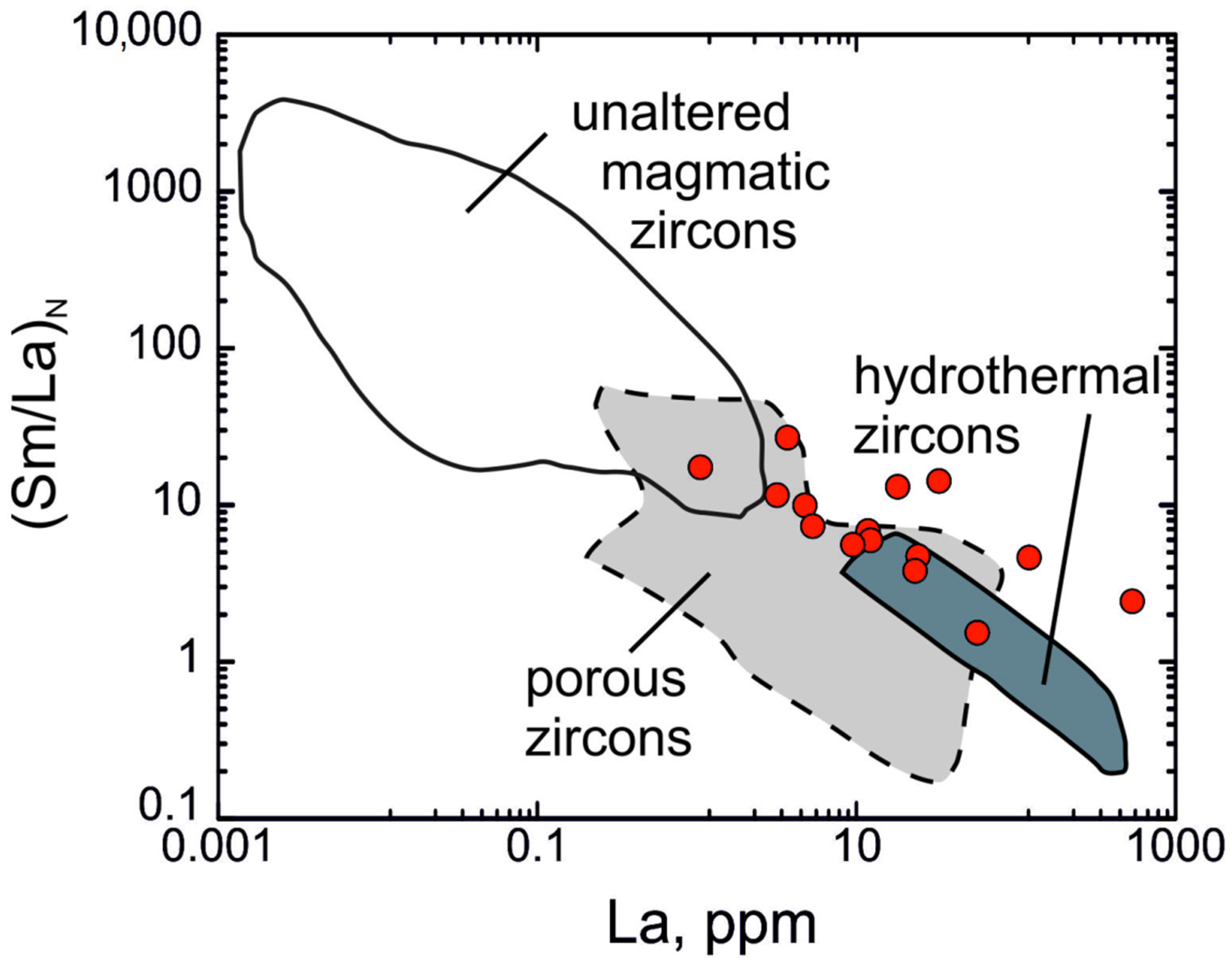


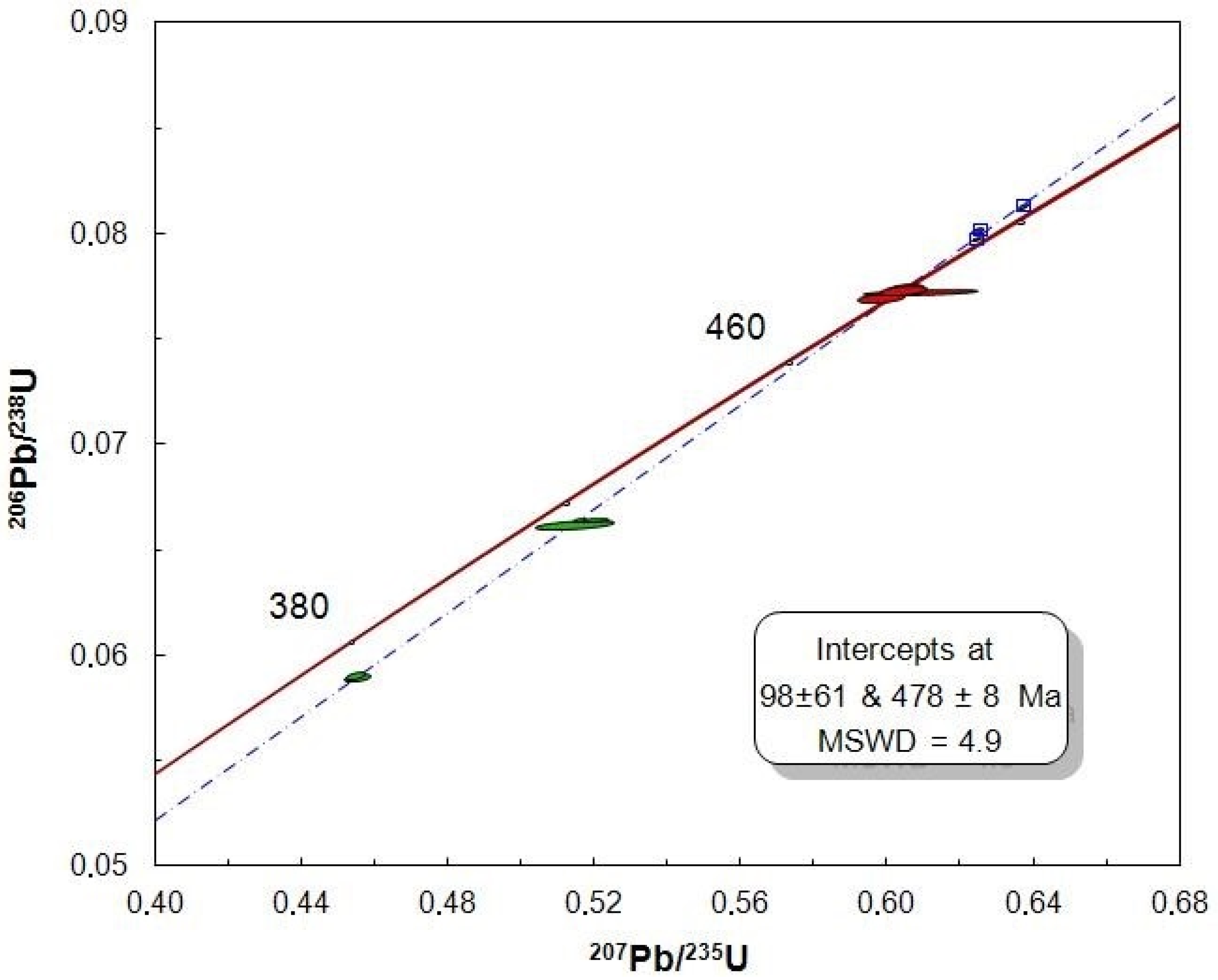
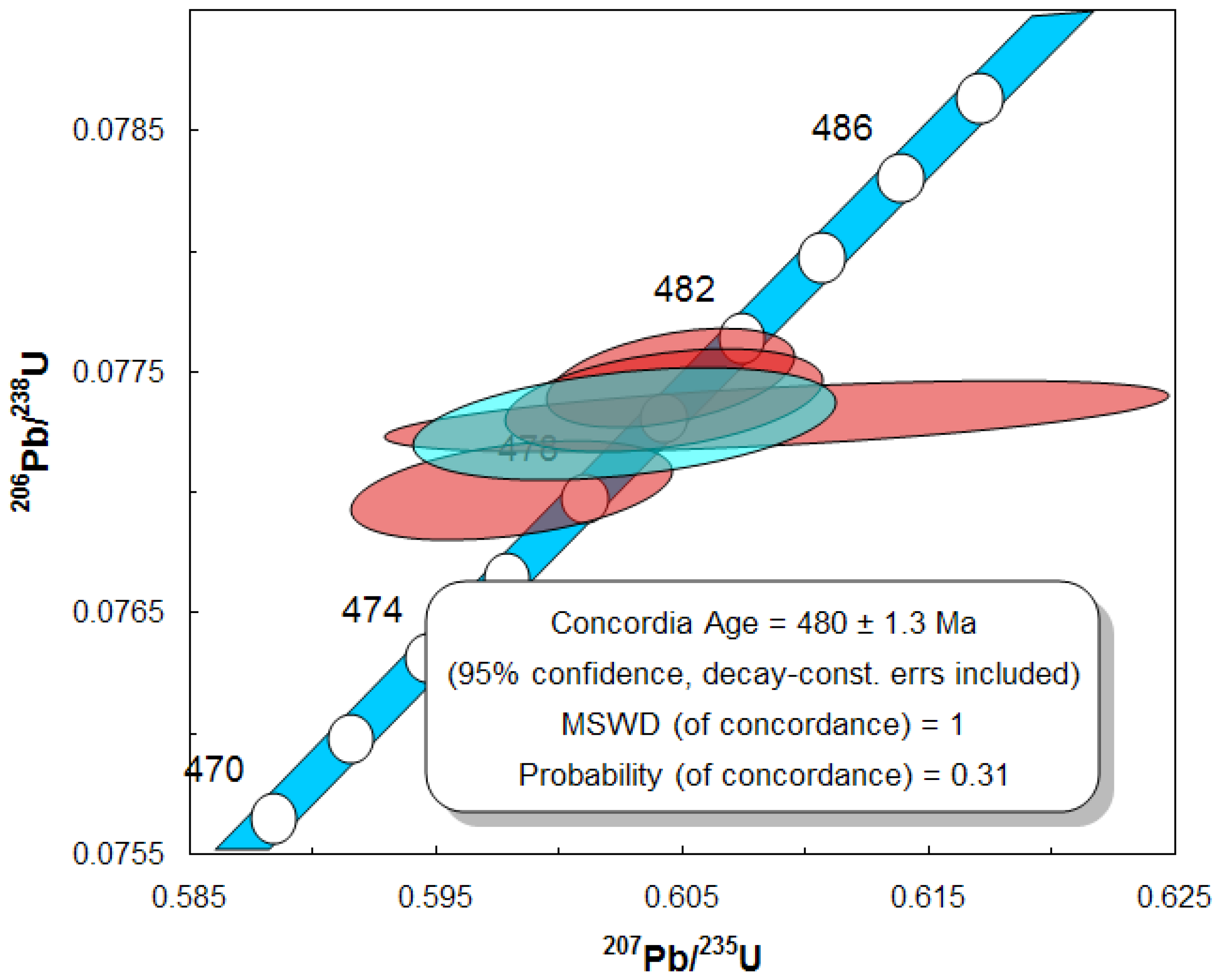

| Spot | % 206Pbc | Ppm U | Ppm Th | Ppm 206Pb* | 232Th 238U | Age 206Pb/238U | 207Pb* 206Pb* | ±% | 207Pb* 235U | ±% | 206Pb* 238U | ±% | Err Corr | |
|---|---|---|---|---|---|---|---|---|---|---|---|---|---|---|
| Sample 108-B | ||||||||||||||
| 1.1 | 0.65 | 10,214 | 1976 | 600 | 0.20 | 424 | ±9 | 0.0559 | 1.0 | 0.52 | 2.3 | 0.0679 | 2.1 | 0.89 |
| 2.1 | 0.08 | 8052 | 1608 | 437 | 0.21 | 394 | ±7 | 0.0549 | 0.5 | 0.48 | 1.9 | 0.0631 | 1.9 | 0.97 |
| 3.1 | 1.23 | 463 | 325 | 49 | 0.72 | 736 | ±13 | 0.0648 | 3.1 | 1.08 | 3.6 | 0.1209 | 1.9 | 0.53 |
| 4.1 | 1.55 | 2474 | 1548 | 171 | 0.65 | 492 | ±9 | 0.0549 | 2.9 | 0.60 | 3.5 | 0.0792 | 1.9 | 0.54 |
| 5.1 | 0.05 | 566 | 229 | 37 | 0.42 | 474 | ±9 | 0.0573 | 1.5 | 0.60 | 2.5 | 0.0763 | 1.9 | 0.79 |
| 6.1 | 21.32 | 3666 | 6030 | 176 | 1.70 | 277 | ±6 | 0.0570 | 19.0 | 0.35 | 19.0 | 0.0439 | 2.2 | 0.11 |
| 7.1 | 0.03 | 3341 | 3627 | 223 | 1.12 | 483 | ±9 | 0.0569 | 0.6 | 0.61 | 2.0 | 0.0778 | 1.9 | 0.96 |
| 8.1 | 0.06 | 1243 | 847 | 81 | 0.70 | 473 | ±9 | 0.0558 | 1.0 | 0.59 | 2.1 | 0.0761 | 1.9 | 0.89 |
| 9.1 | 5.78 | 2287 | 1533 | 116 | 0.69 | 350 | ±7 | 0.0515 | 4.8 | 0.40 | 5.1 | 0.0558 | 1.9 | 0.37 |
| 10.1 | 0.01 | 1548 | 805 | 103 | 0.54 | 481 | ±9 | 0.0571 | 0.8 | 0.61 | 2.1 | 0.0775 | 1.9 | 0.92 |
| Sample DV-27/04 | ||||||||||||||
| 7.1 | 26.35 | 2951 | 3440 | 79 | 1.20 | 197 | ±11 | 0.0483 | 146 | 0.21 | 146 | 0.0311 | 5.9 | 0.04 |
| 10.1 | 2.00 | 2485 | 1743 | 76 | 0.72 | 226 | ±3 | 0.0527 | 5 | 0.26 | 5 | 0.0357 | 1.1 | 0.21 |
| 4.1 | 31.20 | 5240 | 1270 | 187 | 0.25 | 262 | ±5 | 0.0485 | 32 | 0.28 | 32 | 0.0415 | 2.0 | 0.06 |
| 6.1 | 43.02 | 2541 | 754 | 110 | 0.31 | 318 | ±3 | 0.0318 | 38 | 0.22 | 38 | 0.0505 | 1.1 | 0.03 |
| 8.1 | 27.49 | 1682 | 617 | 77 | 0.38 | 336 | ±8 | 0.0429 | 55 | 0.32 | 55 | 0.0535 | 2.4 | 0.04 |
| 2.1 | 17.49 | 2108 | 1086 | 107 | 0.53 | 368 | ±4 | 0.0438 | 16 | 0.36 | 16 | 0.0588 | 1.0 | 0.07 |
| 5.1 | 2.76 | 724 | 369 | 47 | 0.53 | 472 | ±14 | 0.0580 | 9 | 0.61 | 9 | 0.0759 | 3.1 | 0.33 |
| 9.1 | 0.55 | 1561 | 1027 | 102 | 0.68 | 473 | ±6 | 0.0570 | 3 | 0.60 | 3 | 0.0762 | 1.3 | 0.39 |
| 10.2 | 0.23 | 928 | 471 | 61 | 0.52 | 476 | ±3 | 0.0552 | 2 | 0.58 | 2 | 0.0767 | 0.7 | 0.41 |
| 11.1 | 0.20 | 934 | 297 | 62 | 0.33 | 480 | ±3 | 0.0552 | 3 | 0.59 | 3 | 0.0772 | 0.7 | 0.24 |
| 3.1 | 0.17 | 607 | 271 | 41 | 0.46 | 482 | ±5 | 0.0566 | 2 | 0.61 | 2 | 0.0777 | 1.0 | 0.51 |
| 1.1 | 16.73 | 477 | 237 | 32 | 0.51 | 484 | ±8 | 0.0677 | 11 | 0.73 | 12 | 0.0781 | 1.6 | 0.14 |
| Spot | Central Parts | Marginal Parts | |||||||||||||
|---|---|---|---|---|---|---|---|---|---|---|---|---|---|---|---|
| 1.1 | 2.1 | 3.1 | 4.1 | 5.1 | 6.1 | 7.1 | 8.1 | 9.1 | 11.1 | 3.2 | 4.2 | 7.2 | 10.1 | 10.2 | |
| La | 4.76 | 11.8 | 3.17 | 24.4 | 1.05 | 23.4 | 33.0 | 18.2 | 3.68 | 9.48 | 57.5 | 540 | 121 | 5.33 | 12.3 |
| Ce | 28.9 | 50.5 | 20.3 | 123 | 13.0 | 82.2 | 209 | 73.7 | 30.7 | 46.6 | 170 | 1624 | 503 | 44.3 | 72.9 |
| Pr | 3.52 | 7.84 | 2.32 | 17.5 | 0.79 | 11.2 | 36.8 | 13.5 | 3.44 | 5.11 | 24.5 | 266 | 83.1 | 3.64 | 7.47 |
| Nd | 22.8 | 45.3 | 18.4 | 91.7 | 8.53 | 60.2 | 269 | 104 | 35.4 | 32.5 | 117 | 1348 | 456 | 23.3 | 47.0 |
| Sm | 29.2 | 49.9 | 22.6 | 70.9 | 11.3 | 54.6 | 290 | 146 | 61.3 | 32.5 | 53.9 | 807 | 344 | 24.1 | 44.9 |
| Eu | 5.30 | 9.03 | 2.73 | 15.9 | 0.92 | 6.79 | 41.8 | 19.9 | 5.74 | 3.58 | 17.4 | 95.6 | 65.5 | 4.03 | 7.12 |
| Gd | 80.5 | 125 | 72.7 | 173 | 46.8 | 146 | 648 | 374 | 173 | 83.7 | 102 | 1475 | 612.3 | 68.1 | 99.6 |
| Dy | 257 | 462 | 249 | 604 | 161 | 449 | 1944 | 1093 | 533 | 313 | 395 | 3452 | 1678 | 215 | 395 |
| Er | 388 | 640 | 388 | 1082 | 282 | 660 | 2585 | 1381 | 782 | 479 | 778 | 3717 | 1993 | 369 | 597 |
| Yb | 674 | 1163 | 697 | 2014 | 492 | 1093 | 4454 | 2208 | 1278 | 816 | 1614 | 5891 | 3348 | 633 | 1011 |
| Lu | 101 | 162 | 100 | 284 | 84.7 | 155 | 581 | 288 | 177 | 117 | 238 | 755 | 434 | 89.6 | 157 |
| Li | 53.3 | 92.6 | 57.1 | 34.3 | 49.1 | 98.1 | 45.5 | 79.2 | 50.1 | 68.3 | 9.19 | 15.0 | 35.2 | 81.1 | 78.4 |
| P | 462 | 336 | 104 | 370 | 186 | 592 | 902 | 660 | 184 | 526 | 1045 | 8265 | 1558 | 109 | 474 |
| Ca | 252 | 620 | 82.2 | 2228 | 55.8 | 433 | 1768 | 1051 | 329 | 322 | 4230 | 5207 | 2948 | 463 | 425 |
| Ti | 31.9 | 47.1 | 21.0 | 68.0 | 6.57 | 48.7 | 167 | 52.7 | 26.6 | 21.1 | 106 | 1320 | 602 | 30 | 61.7 |
| Sr | 21.0 | 73.7 | 4.29 | 499 | 0.79 | 50.9 | 174 | 67.8 | 9.56 | 34.8 | 733 | 472 | 426 | 84 | 46.3 |
| Y | 2421 | 4332 | 2277 | 6696 | 1737 | 4071 | 18,477 | 10,150 | 4832 | 3645 | 4554 | 27,687 | 13,299 | 2263 | 3527 |
| Nb | 115 | 113 | 67.4 | 153 | 15.1 | 151 | 410 | 170 | 77.2 | 87.1 | 218 | 3107 | 1353 | 79.4 | 198 |
| Ba | 27.2 | 95.1 | 8.55 | 650 | 1.89 | 49.9 | 256 | 126 | 21.9 | 24.7 | 1054 | 558 | 564.3 | 103 | 46.2 |
| Hf | 12,547 | 12,536 | 11,324 | 15,863 | 12,123 | 13,493 | 12,802 | 12,999 | 9208 | 13,462 | 16,017 | 18,156 | 15,952 | 11,699 | 12,284 |
| Th | 602 | 1249 | 502 | 1785 | 381 | 853 | 5139 | 1036 | 1407 | 524 | 1669 | 33,407 | 6970 | 1326 | 960 |
| U | 1367 | 3263 | 1415 | 8948 | 1130 | 3109 | 7423 | 3681 | 2607 | 2284 | 13,889 | 21,979 | 15,945 | 2739 | 2752 |
| Th/U | 0.44 | 0.38 | 0.35 | 0.20 | 0.34 | 0.27 | 0.69 | 0.28 | 0.54 | 0.23 | 0.12 | 1.52 | 0.44 | 0.48 | 0.35 |
| Eu/Eu* | 0.33 | 0.35 | 0.21 | 0.44 | 0.12 | 0.23 | 0.29 | 0.26 | 0.17 | 0.21 | 0.71 | 0.27 | 0.43 | 0.30 | 0.32 |
| Ce/Ce* | 1.71 | 1.27 | 1.81 | 1.44 | 3.45 | 1.23 | 1.45 | 1.14 | 2.09 | 1.62 | 1.10 | 1.04 | 1.21 | 2.43 | 1.84 |
| ΣREE | 1595 | 2726 | 1576 | 4500 | 1102 | 2742 | 11,092 | 5720 | 3083 | 1938 | 3566 | 19,970 | 9638 | 1479 | 2452 |
| ΣLREE | 60.0 | 115 | 44.2 | 256 | 23.4 | 177 | 547 | 209 | 73.3 | 93.7 | 369 | 3777 | 1164 | 76.6 | 140 |
| ΣHREE | 1501 | 2552 | 1506 | 4157 | 1067 | 2503 | 10,213 | 5344 | 2943 | 1808 | 3126 | 15,289 | 8064 | 1375 | 2260 |
| LuN/LaN | 205 | 131 | 303 | 112 | 777 | 63.7 | 170 | 153 | 464 | 118 | 39.9 | 13.5 | 34.4 | 162 | 124 |
| LuN/GdN | 10.2 | 10.4 | 11.1 | 13.3 | 14.6 | 8.57 | 7.25 | 6.24 | 8.29 | 11.3 | 18.8 | 4.14 | 5.73 | 10.6 | 12.8 |
| SmN/LaN | 9.83 | 6.74 | 11.4 | 4.66 | 17.2 | 3.74 | 14.1 | 12.9 | 26.7 | 5.49 | 1.50 | 2.40 | 4.55 | 7.23 | 5.86 |
| T(Ti),°C | 857 | 901 | 813 | 946 | 707 | 905 | 1072 | 914 | 837 | 813 | 1005 | 1491 | 1304 | 849 | 934 |
| No. | Sample | Sm (ppm) | Nd (ppm) | 147Sm/144Nd | 143Nd/144Nd |
|---|---|---|---|---|---|
| 1 | 335-4 | 1.496 | 6.611 | 0.1368 | 0.512283 ± 5 |
| 2 | 352/3 | 5.904 | 4.836 | 0.7381 | 0.514157 ± 5 |
| 3 | B107 | 0.134 | 0.163 | 0.4993 | 0.513392 ± 9 |
| 4 | B109 | 0.051 | 0.197 | 0.1567 | 0.512315 ± 7 |
| Spot | Samples | |||
|---|---|---|---|---|
| 335-4 | 352-3 | B-107 | B-109 | |
| La | 10.4 | 0.61 | 0.67 | 1.63 |
| Ce | 16.7 | 2.09 | 1.08 | 2.37 |
| Pr | 1.68 | 0.56 | 0.071 | 0.086 |
| Nd | 6.5 | 4.65 | 0.24 | 0.33 |
| Sm | 1.47 | 5.57 | 0.14 | 0.066 |
| Eu | 0.31 | 0.067 | 0.019 | 0.026 |
| Gd | 1.54 | 11.9 | 0.18 | 0.094 |
| Tb | 0.28 | 3.23 | 0.042 | 0.017 |
| Dy | 1.79 | 25.9 | 0.33 | 0.082 |
| Ho | 0.39 | 6.56 | 0.075 | 0.021 |
| Er | 1.23 | 20.3 | 0.27 | 0.063 |
| Tm | 0.21 | 2.83 | 0.06 | 0.0082 |
| Yb | 1.63 | 17.8 | 0.59 | 0.055 |
| Lu | 0.24 | 2.07 | 0.092 | 0.0084 |
| W | 16.3 | 0.43 | 0.4 | 25 |
| Sn | 803 | 0.75 | 0.98 | 0.91 |
| Sr | 691 | 2400 | 1410 | 839 |
| Y | 14.4 | 287 | 1.49 | 1.16 |
| Th | 5.27 | 0.93 | 0.68 | 0.11 |
| U | 1.29 | 0.1 | 0.15 | 0.19 |
| Th/U | 4.085 | 9.3 | 4.53 | 0.57 |
| Eu/Eu* | 0.1383 | 0.005 | 0.0826 | 0.2300 |
| Ce/Ce* | 1.4857 | 2.3483 | 1.5308 | 1.4166 |
| Y/Y* | 7.254 | 9.835 | 4.054 | 12.540 |
| ΣREE | 44.37 | 104.137 | 3.859 | 4.8566 |
| ΣLREE | 38.6 | 25.447 | 2.4 | 4.602 |
| ΣHREE | 5.77 | 78.59 | 1.459 | 0.2546 |
| LREE/HREE | 6.68 | 0.32 | 1.64 | 18.41 |
| La/Yb | 6.3803 | 0.034 | 1.1355 | 29.636 |
| La/Ho | 26.666 | 0.0929 | 8.9333 | 77.619 |
| La/Nd | 1.6 | 0.1311 | 2.7916 | 4.9393 |
| Gd/Yb | 0.944 | 0.668 | 0.305 | 1.709 |
| Y/Ho | 36.92 | 43.75 | 19.86 | 55.23 |
| No | Treatment Conditions | Wt (mg) | Pb ppm | U ppm | Isotopic Ratios | Rho | Age, Ma | ||||||
|---|---|---|---|---|---|---|---|---|---|---|---|---|---|
| 206Pb/204Pb a | 207Pb/204Pb a | Err-Corr 7/4-6/4 | 207Pb/235U | 206Pb/238U | 206Pb/238U | 207Pb/235U | 207Pb/206Pb | ||||||
| Yaroslavskoe deposit, sample DV-1 | |||||||||||||
| 1 | 2N HCl + 2N HNO3 | 20.3 | 0.27 | 1.03 | 42.7 (0.317) | 16.930 (0.12) | 0.64 | ||||||
| 2 | 6N HCl + 6N HNO3 | 22.35 | 1.76 | 5.53 | 37.4 (0.068) | 16.668 (0.09) | 0.91 | ||||||
| 3 | 6N HCl + 6N HNO3 (repeat No2) | 8.11 | 1.88 | 5.60 | 36.1 (0.105) | 16.601 (0.093) | 0.70 | ||||||
| 4 | aqua regia | 15.93 | 1.77 | 5.10 | 35.8 (0.077) | 16.604 (0.093) | 0.87 | 0.60891 (2.1) | 0.07731 (0.16) | 0.58 | 480 ± 0.7 | 482.9 ± 10 | 496.4 ± 9.8 |
| 5 | HF 220 °C, 6N HCl + 6N HNO3 | 15.23 | 0.74 | 4.88 | 77.8 (0.244) | 18.971 (0.11) | 0.73 | 0.60465 (0.68) | 0.07747 (0.22) | 0.43 | 481 ± 1 | 480.2 ± 3 | 476.2 ± 3 |
| 6 | HF 220 °C, aqua regia | 26.0 | 0.91 | 5.09 | 62.6 (0.12) | 18.099 (0.096) | 0.71 | 0.59824 (0.88) | 0.07700 (0.22) | 0.39 | 478.2 ± 1 | 476.1 ± 2 | 465.9 ± 2 |
| 7 | HF 220 °C, aqua regia, 6N HCl + 6N HNO3 | 11.9 | 0.77 | 4.31 | 63.5 (0.256) | 18.161 (0.108) | 0.70 | 0.60437 (0.86) | 0.07738 (0.23) | 0.39 | 480.5 ± 1 | 480 ± 4 | 477.8 ± 4 |
| 8 | HF 220 °C, HBr | 26.61 | 0.83 | 4.96 | 71.5 (0.126) | 18.698 (0.095) | 0.71 | ||||||
| 9 | leach 2N HCl + 2N HNO3 | - | - | - | 18.6 (0.06) | 15.626 (0.09) | 0.99 | ||||||
| 10 | pyrite | - | - | - | 18.3 (0.012) | 15.601 (0.018) | 0.99 | ||||||
| Yaroslavskoe deposit, sample 4088-112 | |||||||||||||
| 11 | 6N HCl + 6N HNO3 | 16.6 | 0.49 | 6.18 | 839 (3) | 62.231 (2.33) | 0.99 | 0.63736 (0.17) | 0.08137 (0.11) | 0.71 | 504.3 ± 0.6 | 500.7 ± 0.9 | 484 ± 0.6 |
| 12 | 6N HCl + 6N HNO3 | 19.5 | 0.53 | 6.46 | 649 (1.9) | 51.175 (1.39) | 0.99 | 0.62448 (0.21) | 0.08024 (0.11) | 0.61 | 497.6 ± 0.6 | 492.7 ± 1 | 469.8 ± 0.8 |
| 13 | 6N HCl + 6N HNO3 (twice) | 12.2 | 0.48 | 6.1 | 917 (5.1) | 66.608 (4.1) | 0.99 | 0.62433 (0.16) | 0.07986 (0.11) | 0.76 | 495 ± 0.6 | 492.6 ± 0.8 | 481 ± 0.5 |
| Chapaevskoe deposit, sample 4088-107 | |||||||||||||
| 14 | 6N HCl + 6N HNO3 | 20.5 | 1.6 | 10.2 | 54.6 (0.1) | 17.636 (0.1) | 0.81 | 0.45529 (0.65) | 0.05904 (0.23) | 0.47 | 369.8 ± 0.8 | 381 ± 6.5 | 449.8 ± 2.8 |
| 15 | 6N HCl + 6N HNO3 | 17.0 | 1.5 | 11.3 | 67.8 (0.11) | 18.367 (0.09) | 0.72 | 0.45465 (0.45) | 0.05914 (0.22) | 0.56 | 368 ± 0.8 | 378.8 ± 1.7 | 444.9 ± 1.7 |
| 16 | 6N HCl + 6N HNO3 | 10.1 | 0.64 | 6.40 | 125 (0.97) | 21.596 (0.69) | 0.88 | 0.51465 (1.7) | 0.06624 (0.0.25) | 0.55 | 413.5 ± 1 | 421.6 ± 7 | 466.1 ± 7.3 |
| 17 | 6N HCl + 6N HNO3 | 15.8 | 1.33 | 6.86 | 49.0 (0.096) | 17.374 (0.09) | 0.74 | 0.51970 (0.62) | 0.06647 (0.12) | 0.43 | 414.8 ± 0.5 | 425.0 ± 2.6 | 480.2 ± 2.8 |
| 18 | 6N HCl + 6N HNO3 (twice) | 9.45 | 0.60 | 6.22 | 136 (0.95) | 22.201 (0.36) | 0.95 | 0.51611 (0.27) | 0.06652 (0.11) | 0.5 | 415.2 ± 0.5 | 422.6 ± 1.2 | 463.1 ± 1.1 |
Publisher’s Note: MDPI stays neutral with regard to jurisdictional claims in published maps and institutional affiliations. |
© 2021 by the authors. Licensee MDPI, Basel, Switzerland. This article is an open access article distributed under the terms and conditions of the Creative Commons Attribution (CC BY) license (https://creativecommons.org/licenses/by/4.0/).
Share and Cite
Rizvanova, N.G.; Alenicheva, A.A.; Skublov, S.G.; Sergeev, S.A.; Lykhin, D.A. Early Ordovician Age of Fluorite-Rare-Metal Deposits at the Voznesensky Ore District (Far East, Russia): Evidence from Zircon and Cassiterite U–Pb and Fluorite Sm–Nd Dating Results. Minerals 2021, 11, 1154. https://doi.org/10.3390/min11111154
Rizvanova NG, Alenicheva AA, Skublov SG, Sergeev SA, Lykhin DA. Early Ordovician Age of Fluorite-Rare-Metal Deposits at the Voznesensky Ore District (Far East, Russia): Evidence from Zircon and Cassiterite U–Pb and Fluorite Sm–Nd Dating Results. Minerals. 2021; 11(11):1154. https://doi.org/10.3390/min11111154
Chicago/Turabian StyleRizvanova, Nailya G., Antonina A. Alenicheva, Sergey G. Skublov, Sergey A. Sergeev, and Dmitriy A. Lykhin. 2021. "Early Ordovician Age of Fluorite-Rare-Metal Deposits at the Voznesensky Ore District (Far East, Russia): Evidence from Zircon and Cassiterite U–Pb and Fluorite Sm–Nd Dating Results" Minerals 11, no. 11: 1154. https://doi.org/10.3390/min11111154
APA StyleRizvanova, N. G., Alenicheva, A. A., Skublov, S. G., Sergeev, S. A., & Lykhin, D. A. (2021). Early Ordovician Age of Fluorite-Rare-Metal Deposits at the Voznesensky Ore District (Far East, Russia): Evidence from Zircon and Cassiterite U–Pb and Fluorite Sm–Nd Dating Results. Minerals, 11(11), 1154. https://doi.org/10.3390/min11111154







